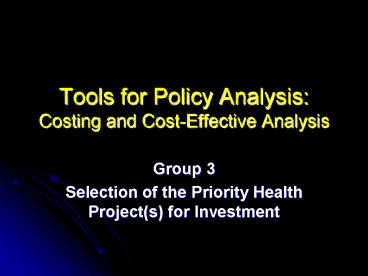Tools for Policy Analysis: Costing and Cost-Effective Analysis - PowerPoint PPT Presentation
1 / 17
Title:
Tools for Policy Analysis: Costing and Cost-Effective Analysis
Description:
Dr Mohammad Ali Khalifa. Facilitator: Dr Sameen Siddiqi. Group members: Dr Bothaina Attal ... MoF releases $ 10 million to MoH for investment in priority areas ... – PowerPoint PPT presentation
Number of Views:86
Avg rating:3.0/5.0
Title: Tools for Policy Analysis: Costing and Cost-Effective Analysis
1
Tools for Policy AnalysisCosting and
Cost-Effective Analysis
- Group 3
- Selection of the Priority Health Project(s) for
Investment
2
- Head of the group
- Dr Ali Khadr
- Rapporteur
- Dr Mohammad Ali Khalifa
- Facilitator
- Dr Sameen Siddiqi
- Group members
- Dr Bothaina Attal
- Dr Sanaa Naffa
- Dr Ishtawi Abu Zayed
- Dr Riham Asady
- Dr Kushkhal Khan
- Dr Ali Khadr
- Dr Akihiro Seita
- Dr Besrat Hagos
- Dr Nasr El Tantawy
3
- Exercise elements
- MoF releases 10 million to MoH for investment
in priority areas - Very short notice
- The unspent money will be lost
- A list of projects is prepared by MoH
- Selection by a decision making committee
4
Project Total DALYs averted Number of people affected Cost in C/B Ratio
A 1000 100,000 5,000,000 5000
B 1000 50 5,000,000 5000
C 2000 1000 10,000,000 5000
D 1000 20 4,000,000 4000
E 10,000 500,000 1,000,000 100
F 40 20 4,000,000 100,000
5
- Role Play by the group members
6
- Issues raised and discussed during the selection
process - Two scenarios
- (1) Business as usual approach
- 1- Timeline very limited (as soon as possible,
otherwise the money will be lost, very limited
time for planning) - 2- Was it a trick by the MoF ?
- 3- Was there a hidden agenda behind this very
short notice? - 4- The money will be used by interest and
pressure groups to be directed towards
pre-defined areas ?
7
- (2) Revolutionary new approach
- To adopt scientific criteria
- 1- Total DALYs averted by the selected project(s)
- 2- Number of people affected by the selected
project(s) - 3- Cost effective analysis
- 4- Ethical issues
8
- Decision
9
Project Total DALYs averted Number of people affected Cost in C/B Ratio
A 1000 100,000 5,000,000 5000
B 1000 50 5,000,000 5000
C 2000 1000 10,000,000 5000
D 1000 20 4,000,000 4000
E (1st) 10,000 500,000 1,000,000 100
F 40 20 4,000,000 100,000
10
- 1st Choice Project E
- Justification
- The largest number of beneficiaries
- The highest total DALYs averted
- The most effective cost for total DALYs
- averted
- Possible epidemic which needs prompt intervention
(e.g viral hepatitis A) ???
11
Project Total DALYs averted Number of people affected Cost in C/B Ratio
A 1000 100,000 5,000,000 5000
B 1000 50 5,000,000 5000
C 2000 1000 10,000,000 5000
D (2nd) 1000 20 4,000,000 4000
E 10,000 500,000 1,000,000 100
F 40 20 4,000,000 100,000
12
- 2nd Choice Project D
- Justification
- The next most effective cost for total
- DALYs averted
- It was selected for ethical reasons considering
the seriousness of the expected health problem
and its catastrophic effect on public health and
population if it is not controlled and eliminated
within a very short time. This justifies the
selection despite the apparently very limited
number of beneficiaries. - Possibly child leukemia
13
Project Total DALYs averted Number of people affected Cost in C/B Ratio
A (3rd) 1000 100,000 5,000,000 5000
B 1000 50 5,000,000 5000
C 2000 1000 10,000,000 5000
D 1000 20 4,000,000 4000
E 10,000 500,000 1,000,000 100
F 40 20 4,000,000 100,000
14
- 3rd Choice Project A
- Justification
- It ranks the 3rd with regard C/B ratio
- The 2nd largest number of beneficiaries
- Possibly elderly pneumonia
15
Project Total DALYs averted Number of people affected Cost in C/B Ratio
A 1000 100,000 5,000,000 5000
B 1000 50 5,000,000 5000
C (???) 2000 1000 10,000,000 5000
D 1000 20 4,000,000 4000
E 10,000 500,000 1,000,000 100
F 40 20 4,000,000 100,000
16
Project How many cases expected to be prevented per 1000 population with each project selection?
A 10 per 1000
B 20,000 per 1000
C 2000 per 1000
D 50,000 per 1000
E 20 per 1000
F 2000 per 1000
17
Thank you































